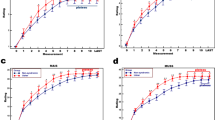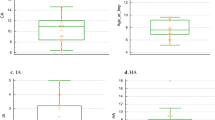Abstract
Usher’s syndrome is an autosomal recessive disorder characterized by dual sensory impairment involving both the ears and eyes. Cochlear implantation paves a way to restore hearing loss in such individuals but poor vision among these patients poses additional challenges for the habilitationists. This study aimed to compare the habilitation outcomes and hearing-related quality of life scores of cochlear implantees having Usher syndrome with age-matched cochlear implantees with no such syndromic association. 27 patients aged 1–6 years with Usher syndrome underwent cochlear Implantation over a period of 10 years from 2006 to 2016 and were included in this study along with an age-matched cohort of 30 implantees with no additional disabilities. Category of Auditory Performance (CAP) and Speech Intelligibility Rating (SIR) scores were compared at 3, 6, 9 and 12 months respectively. Glasgow Benefit Inventory and Health Utility Index (HUI 3.0) questionnaires were used to assess the hearing-related quality of life in both groups at 1 year post implantation. There was significant difference in CAP and SIR scores between children with Usher’s syndrome and the control group (p < 0.05). The overall scores in terms of quality of life as well were statistically different (p < 0.05). Though there was improvement in speech and language acquisition after cochlear Implantation this was found to be of lesser extent than the normative cohort. These children with additional visual disabilities required intensive, individualized therapy catering to their complex needs. Their family’s perception of expected benefit from cochlear Implantation was guarded and needed to be appraised in detail prior to surgery. This experience helped prepare an institutional protocol for counseling such implantees in future.


Similar content being viewed by others
References
Usher CH (1935) Bowman’s lecture: on a few hereditary eye affections. Trans Ophthalmol Soc UK 55:164–245
Vernon M (1969) Sociological and psychological factors associated with hearing loss. J Speech Hear Res 12(3):541–563
Fortnum HM, Summerfield AQ, Marshall DH, Davis AC, Bamford JM (2001) Prevalence of permanent childhood hearing impairment in the United Kingdom and implications for universal neonatal hearing screening: questionnaire based ascertainment study. BMJ 323:536–539
Boughman JA, Vernon M, Shaver KA (1983) Usher syndrome: definition and estimate of prevalence from two high-risk populations. J Chronic Dis 36(8):595–603
Marazita ML, Ploughman LM, Rawlings B, Remington E, Arnos KS, Nance WE (1993) Genetic epidemiological studies of early-onset deafness in the U.S. school-age population. Am J Med Genet 469(5):486–491
Merin S, Auerbach E (1976) Retinitis pigmentosa. Surv Ophthalmol 20:303–345
Samuelson S, Zahn J (1990) Usher′s syndrome. Ophthalmic Paediatr Genet 11:71–76
Smith RJ, Berlin CI, Hejtmancik JF et al (1994) Clinical diagnosis of the usher syndromes. Am J Med Genet 50(1):32–38
Reisser CF, Kimberling WJ, Otterstedde CR et al (2002) Hearing loss in Usher syndrome type II is nonprogressive. Otol Rhinol Laryngol 111:1108–1111
Möller CG, Kimberling WJ, Davenport SL et al (1989) Usher syndrome: an otoneurologic study. Laryngoscope 99(1):73–79
Sadeghi M, Cohn ES, Kelly WJ, Kimberling WJ, Tranebjaerg L, Moller C (2004) Audiological findings in Usher syndrome types IIa and II (non-IIa). Int J Audiol 43:136–143
DeAngelis MM, McGee TL, Keats BJ, Slim R, Berson EL, Dryja TP (2001) Two families from New England with Usher syndrome type IC with distinct haplotypes. Am J Ophthalmol 131(3):355–358
Young NM, Johnson JC, Mets MB, Hain TC (1995) Cochlear implants in young children with Usher’s syndrome. Ann Otol Rhinol Laryngol 9(2):34–45
Dawson PW, Blarney PJ, Rowland LC et al (1992) Cochlear implants in children, adolescents, and pre-linguistically deafened adults: speech perception. J Speech Hear Res 35:401–417
Waltzmann S, Jareen M et al (2013) Outcomes for children with deaf-blindness with cochlear implants: a multisite observational study. Otol Neurotol 34(3):13–21
Wiley S, Meinzen-Derr J, Stremel-Thomas K et al (2013) Outcomes for children with deaf-blindness with cochlear implants: a multisite observational study. Otol Neurotol 34:507–515
Pennings RJ et al (2006) Audiologic performance and benefit of cochlear implantation in Usher syndrome type-I. The Laryngoscope 116(5):717–722. https://doi.org/10.1097/01.mlg.0000205167.08415.9e
Sanders C, Egger M et al (1998) Reporting on quality of life in randomised controlled trials: bibliographic study. BMJ 317(7167):1191–1194
Fitzpatrick R, Davey C, Buxton MJ, Jones DR (1998) Evaluating patient based outcome measures for use in clinical trials. Health Technol Assess (Winch, Engl) 2(14):1–74
Loeffler C, Aschendorff A et al (2010) Quality of life measurements after cochlear implantation. Open Otorhinolaryngol J 4:47–54
Robinson K, Gatehouse S, Browning GG (1996) Measuring patient benefit from otorhinolaryngological surgery and therapy. Ann Otol Rhinol Laryngol 105(6):415–422
Institute of Hearing Research. The Glasgow Health Status Questionnaires Manual 1998. http://www.ihr.mrc.ac.uk. Accessed 1 Sept 2019
The UK Cochlear Implant Study Group (2004) Criteria of candidacy for unilateral cochlear implantation in post-lingually deafened adults I: theory and measures of effectiveness. Ear Hear 25(4):310–335
Pietola L, Aarnisalo AA et al (2012) Speech recognition and communication outcomes with cochlear implantation in Usher syndrome type-III. Otol Neurotol 33:38–41
Author information
Authors and Affiliations
Corresponding author
Ethics declarations
Conflict of interest
The authors declare that they have no conflict of interest.
Ethical approval
Ethical committee approval obtained on 24th June 2016.
Additional information
Publisher's Note
Springer Nature remains neutral with regard to jurisdictional claims in published maps and institutional affiliations.
Rights and permissions
About this article
Cite this article
Nair, G., Dham, R., Sekhar, A. et al. Cochlear Implantation in Children with Usher’s Syndrome: A South Asian Experience. Indian J Otolaryngol Head Neck Surg 72, 140–144 (2020). https://doi.org/10.1007/s12070-019-01759-y
Received:
Accepted:
Published:
Issue Date:
DOI: https://doi.org/10.1007/s12070-019-01759-y




